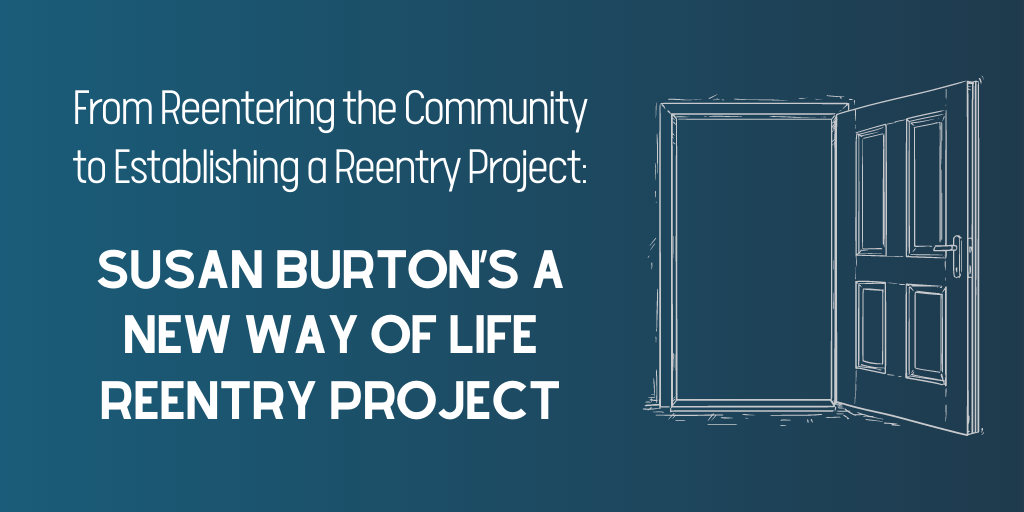Susan Burton knows the pain of the women she serves. Incarcerated multiple times over 15 years, after the accidental death of her young son led her to addiction to cocaine and crack, Burton has since turned heartbreak into hope, and pain into promise. Burton started the A New Way of Life (ANWOL) Reentry Project in 1998 with a 3-bedroom house in the Watts section of Los Angeles, California. Since then, the project has become a nationally and internationally replicated model for helping women leaving incarceration to rebuild their lives, their families, and their communities.
Burton turned her life around with the support she received in a recovery home in Santa Monica, a largely White, affluent community. Her experience there stood in stark contrast to what she knew about the difficulty of accessing services in South L.A., where the population is more racially diverse and less economically advantaged. “It angered me a bit,” Burton says, “but that also fueled me to do something about it.” She used her savings to buy that three-bedroom house in Watts and started meeting women when they got off the bus from prison in Downtown L.A.’s Skid Row.
“I offered them a safe place to go,” Burton says of the founding of ANWOL, of which she is president. “We didn’t have much, but we had enough to maintain the house and to support one another to recover from many things—from incarceration, from addiction, from loss, from family separation. We had time to heal and discover the effects of racism in our lives.”
What differentiates ANWOL from more traditional halfway houses or other government-run housing, which Burton has examined in a narrative evaluation, is the level of freedom the women have to regain control over their lives. They don’t have to check in and out or urinate in a bottle to stay in ANWOL housing, which now includes 10 homes. “Our approach is much different,” Burton explains. “It’s more person-centered. It focuses on the needs of the individual more so than the structure of the program or the housing model.”
ANWOL homes are alcohol- and drug-free environments, which many of the women need to meet the conditions of their parole. Residents attend 12-step meetings, are referred for mental health treatment if needed, and are helped with accessing education or finding a job. Legal staff assist with expungement of criminal records and with family reunification. In 2019, 9 out of every 10 women served ultimately met benchmarks identified as necessary for successful reentry after periods of incarceration, and 99 percent of the women served were not reincarcerated. That year alone, ANWOL accomplished the following:
- Served 78 women (mothers of 63 minor children and 57 adult children)
- Helped 33 women secure permanent housing
- Helped 53 women access education opportunities
- Helped place 45 out of 68 women who were seeking jobs in employment
“One of the things that I think is very different about ANWOL is that we ask people what they need and what they want, then we help them achieve that,” Burton remarks. “They have to put the work in, but the support around connecting them to the various activities they want to engage in is there for them.” Burton also empowers women to act as advocates for social change; working to pass legislation to reform the criminal justice system and restore the civil rights of formerly incarcerated people.
The current scale of operations is a far cry from that three-bedroom house that got it all started, where she slept in the dining room so she could offer as many bedrooms as possible. To replicate her model, Burton has formed the Sisterhood Alliance for Freedom and Equality (SAFE) Housing Network. SAFE offers a free, 3-day training to transfer ANWOL’s learnings to other reentry programs; the network hopes to resume in-person events in 2021. As gratifying as it is to see her organization and approach reaching people who need it, Burton feels a bit nostalgic about those early days. Burton sees ANWOL’s residents as “amazing survivors of so much harm,” but doesn’t get to interact with them as often in her role as president. She has sometimes gone from house to house on the weekend, meeting the new residents, “to talk with them to see what their hopes and dreams were, and get a gauge of how hard they’re willing to work toward those hopes and dreams,” she says.
Burton has some clear recommendations for those who want to replicate her model, including taking the free SAFE training. “I would say look at the need in your community. Nationally, there’s a great need,” Burton advises. “Look at who you’ll partner with and try to figure out your sustainability plan.” For instance, though it receives some government contracts, ANWOL is largely funded through private giving and foundation support.
But it is most important, she believes, to “understand that many times people are really amazing, and sometimes their abilities get smothered in environments that are just not productive, environments that are harmful.” In fact, she points out that many mental health problems are exacerbated by being in a “volatile, oppressive, and harmful environment.” Every time Burton was released from incarceration before Santa Monica, she had gone right back into the same adverse environment. She heard women in prison tell her the same was true for them when she went around the country doing signings for her book, Becoming Ms. Burton. People begin to heal in a “calm, settled, inviting, and warm environment, an environment where they feel connected and a part of the community,” Burton says, and that is what she works to ensure ANWOL residents find.
If all of this sounds like hard work, Burton is here to disabuse you of that notion. “It wasn’t work,” she says. “It was my cause. It was my contribution to the world. It was my hope for something different.”
Like what you’ve read? Sign up to receive the monthly GAINS eNews!


